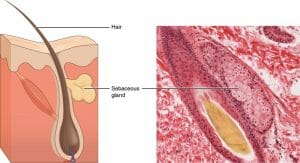Sebaceous Glands Definition
Sebaceous glands are the oil-secreting tissue in mammalian skin. When a slice of the epidermis is examined under a microscope, we see a hair follicle that has pierced through the skin’s surface into the subcutaneous layer. Inside lies the secretory sebaceous tissue. The waxy oil that is secreted into the hair follicles is called the sebum. This oil lubricates the skin and scalp of mammals. Since sebaceous glands secrete their oil into ducts before reaching the surface of the skin, they are considered exocrine glands.

The image depicts an illustration and histological slide of a sebaceous gland.
Sebum is a mixture of fats (triglycerides, cholesterol, squalene, wax esters), debris, and keratin. This forms the light film of oil on the surface of our skin. If you’ve ever taken a picture of yourself and appeared shiny in the frame, it is the sebum that’s made it so.
We may best recognize sebum as the waxy substance on our faces and scalps before we hop in the shower. But really, sebaceous glands are located in every part of the skin except your bottom lip, the palms of your hands, and the soles of your feet. There are two types of sebaceous glands: those that connect to a hair follicle, and those that do not. Those linked to hair follicles deposit sebum onto the hair, which carries it along the length of the follicle. Those that exist in hairless areas of the skin are located on the inside of the nose, the penis, and the labia minora. Likewise, meibomiam glands populate our eyelids and secrete sebum into tears for extra weight and lubrication. Areolar glands circle the nipples and keep the skin from drying or scaling.
At the base of either pore lies the sebaceous gland. It is acinar in structure as acinar glands appear like berry lobes. These lobes, or sacs, secrete the oily suspension.
Sebaceous Glands Development
The sebaceous gland is formed during late embryogenesis to early life. It typically begins its journey during the fourth month of gestation. The stem cells begin to differentiate within the outer root sheath (or ORS), and appear as bulgings, or tiny bags, off of the hair shaft. When these cells disintegrate, they release their oily secretion. Genetics factor into whether a sebaceous gland appears or not, as well. When signaling factors like Wnt and Myc are overexpressed, there is a likelier chance of forming sebaceous glands. In fact, the clear, waxy substance that coats the skin of newborn babies after birth is discharge from a type of sebaceous gland.
However, after birth, sebaceous glands shrink until there is nearly no activity. This changes after the age of six, and reaches the pinnacle of activity at puberty. Gland activity is very much linked to the levels of male hormone, testosterone.
Function of Sebaceous Glands
The main function of the fatty sebaceous gland is to lubricate the skin. This prevents the loss of moisture. In turn, the skin remains moisturized and flexible. Without sebum the skin would dry and lacerate easily. Dry patches are more prone to infection, as pathogens are able to penetrate through broken skin. This proves the importance of sebum in keeping the skin intact.
The sebum in our hair strands, on the other hand, make our hair waterproof. As mentioned before, an important component of sebum (and hair) is keratin. Water is unable to penetrate or break the strands. Without sebum, hair would have no protective barrier against becoming brittle or even evaporating. On an evolutionary basis, of course, hair protects the skin from environmental harm.
Sebaceous Glands Problems
Sebum underproduction or overproduction creates some complications. Like most processes, homeostatic control balances this delicate line. Underproductive glands will lead to skin breakage and infection. Over productive sebaceous glands are involved in the very common skin affliction, acne vulgaris. Papules form when a sebaceous gland clogs, which allows sebum to collect in the follicle and duct. The eventual bacterial breakdown of triglycerides in the sebum will release fatty acids that will trigger inflammatory lesions, or “pimples.” Likewise, overactive glands can cause sebaceous cysts. These are painful pockets of pus that form within the sebaceous ducts when they become clogged. Unlike acne papules that are close to the surface of the skin, cysts will be deeper in the skin and painful to the touch due to their proximity to dermal nerves.
Overactive sebaceous glands are also linked to more serious afflictions, hyperplasia and sebaceous adenoma. Hyperplasia refers to the quick growth of tissue that may signal the initial phase of cancer. Similarly, adenomas are lumps of cells in the sebaceous duct that may be a sign of internal disease. Sebaceous carcinoma is a rare but lethal tumor of the skin that originates in the gland.
Quiz
1. Sebaceous glands belong to which of the following glandular groups?
A. mesocrine
B. endocrine
C. exocrine
D. paracrine
2. What shape does the sebaceous gland take on?
A. Tubular
B. Alveolar
C. Tubulo-alveolar
D. Acinar
References
- Britannica (2017). “Sebaceous Gland.” Britannica: Anatomy. Retrieved on 2017-06-21 from https://www.britannica.com/science/sebaceous-gland
- Zouboulis CC (2004). “Acne and sebaceous gland function.” Clin Dermatol. 22(5): 360-6.
- LifeMap Discovery (2017). “Sebaceous Gland.” Discovery. Retrieved on 2017-06-21 from https://discovery.lifemapsc.com/in-vivo-development/hair/sebaceous-gland
- Encycolpedia Britannica (2017). “Sebaceous gland.” Britannica: Anatomy. Retrieved on 2017-06-21 from https://www.ncbi.nlm.nih.gov/pubmed/22960253
